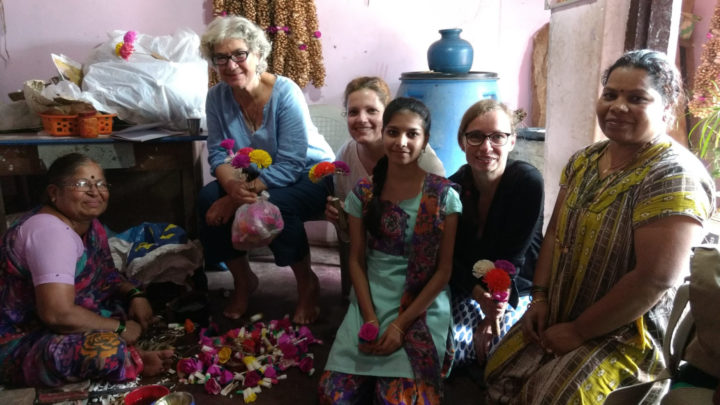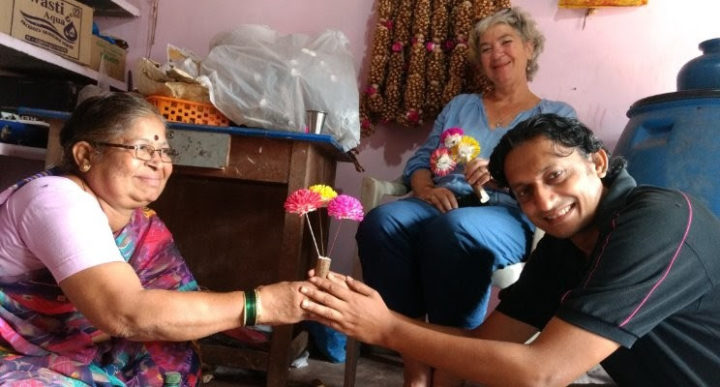TRADITIONAL CRAFTS
By B C Kiran
Gudigar or Gudigara are craftsmen residing in the state of Karnataka, India. Their traditional profession was to build temples and places of worship. The skills were passed on only in the families of Gudigaras. Today they have diversified into many types of crafts.

Sharada Gudigar in Banavasi. Seen on the wall is Sandal Wood Garland. The bouquet is made from Pith.
The word ‘Gudi’ stands for temple in Kannada and ‘Gudigar’ is temple artisan or craftsman. Earliest workers were believed to be employed by Kadamba kings Banavasi. The craftmen resided in coastal region around Banavasi and Goa. After mass conversions were undertaken by the Portuguese, they seem to have come down to Shimoga and Canara coast. They are versatile craftsmen. They carve, paint, sculpt and mould earth to prepare idols. They work on pith garlands and coronets and prepare trinkets. Earlier many well-to-do Gudigars owned land and were agriculturists. Later some excelled in Sandalwood carving, ebony and ivory carving. With depletion of Sandalwood growth and diminishing forest wealth they took to wood carving. Ivory carving is totally banned in India, because of the harm caused to elephant tusks with that, the most ancient and precious art came to an end.
Huen Tsang the Chinese traveler-monk who was in India between 630-644 A.D visited Banavasi. He has recorded that there were a hundred monasteries of both Hinayana and Mahayana sects with 10,000 Buddhist monks and priests. He states that a huge sandalwood image of Buddha had miraculous powers. Sandalwood was the prime product of Banavasi region (Malenad). Huen Tsang’s special mention of sandalwood Buddha makes Gudigars famous since ancient times.
Banavasi and the region around was the ancient trade centre acknowledged by the Greco-Roman writer Ptolemy in his treatise. Sandalwood carvings, Ivory carving, stone sculpture were all exported from this region and the Gudigars played a vital role in shaping the economy of the region.
In Banavasi, we work with Sharada Gudigar and family. Their families have been in Banavasi for many years. Her husband believes that their family has been around in Banavasi from the time Mayura Verma founded the Kadamba dynasty.
She does not fully depend on the art for her livelihood. She gets an old age pension from the government. She also runs a small shop at her residence to augment her income. She gets a good income from the tourist who come to her thru the responsible tourism initiative of Outdoor World Sustainable tourism Banavasi.
She excels in making pith basinga, pith bouquets, pith garland, sandalwood look alike garlands and other small decorative items from pith. She has been to Delhi and got awards from ministry of crafts and culture.
What can a corporation do?
It does not take much to change their lives. We all know that it’s a common practice in companies to gift its employees, shareholders, customers during Deepawali and Christmas. Even if one big company decides that it will not buy a Chinese products and offers to buy from this Gudigar, her life will change. If we change the way we buy, we will definitely change the way they live.
We would be glad to help anyone in their pursuit to bring a change for artists in Banavasi and surrounding area
About the writer:
 B.C.Kiran. A social entrepreneur who has been working in Banavasi community development for the past decade. Instrumental in developing rural and sustainable tourism in Banavasi.
B.C.Kiran. A social entrepreneur who has been working in Banavasi community development for the past decade. Instrumental in developing rural and sustainable tourism in Banavasi.






